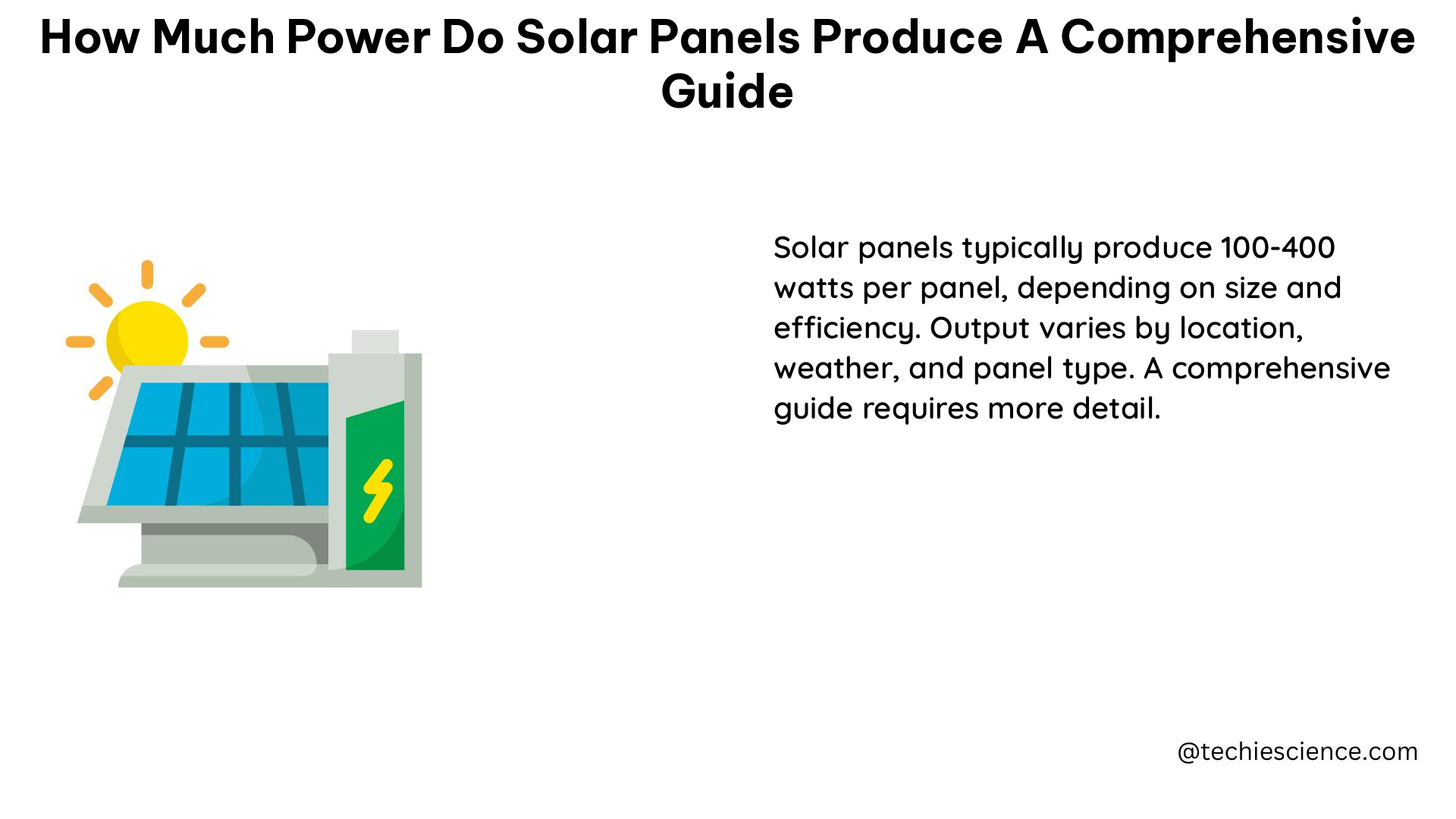The power output of solar panels is a crucial factor to consider when transitioning to renewable energy. Solar panels have a power output rating that typically ranges from 250 to 400 watts (W) under standard testing conditions. The average residential solar panel has a power output rating of 250 to 400 watts and generates around 1.5 kilowatt-hours (kWh) of energy per day. Most homes can meet their energy needs using 20 solar panels, which typically have an installed system capacity of six to eight kilowatts (kW). However, the actual output constantly changes once installed and depends on the type of photovoltaic (PV) solar panels used and external factors like sunshine and ambient temperature.
Understanding Solar Panel Wattage and Efficiency
The wattage of a solar panel measures how much energy it produces under standard testing conditions, and it is determined using Standard Test Conditions (STC) that include an irradiance of 1000 W/m2, a cell temperature of 25°C, and an air mass of 1.5. The output measured under laboratory conditions determines the rated wattage of a solar panel, and this testing also dictates the solar panel efficiency rating.
For example, if a PV module generates 220 W per square meter, it is 22% efficient. As of June 2023, SunPower and Canadian Solar produce the most efficient solar panels in the industry, both reaching 22.8% efficiency. However, many other brands make solar panels with an efficiency of over 20%. High-efficiency monocrystalline panels can generate more watts of power compared to thin-film and polycrystalline panels, making them ideal for homeowners with limited space who want to achieve the highest possible electricity output.
Factors Affecting Solar Panel Power Output

The average residential solar panel has a power output rating of 250 to 400 watts, and generates approximately 1.5 kWh of electricity per day. Manufacturers use specific laboratory conditions to determine solar panel wattage, so the actual output will vary depending on factors such as sunlight exposure, temperature conditions, and how much energy is lost by other system components.
To maximize solar production, you can use high-efficiency monocrystalline panels, opt for a professional installation, and keep your panels free of dirt and debris that could block sunlight. Your solar installer can calculate the ideal system size for your home based on your electricity usage, energy needs, and site conditions.
Estimating Solar Panel Power Output
Since companies test solar panels under the same conditions, you can compare power output directly when shopping for panels. Installers also use rated wattages to size solar power systems and estimate electricity production. The average solar panel generates 1.5 kWh of energy each day, and solar panel productivity largely depends on rated wattage and local sunshine conditions.
You can estimate solar panel power output by multiplying a panel’s efficiency rating by your location’s peak sunlight hours, which you can find using the Global Solar Atlas. For example, a 400 W panel in an area with 4.3 watt-hours of peak sunlight would generate 1,720 watt-hours or 1.7 kWh of energy each day. The main factor that determines panel power output is the type of solar cell, with monocrystalline panels being the most efficient.
DIY Guide to Maximizing Solar Panel Power Output
- Determine your energy needs by reviewing your electric bills from several months to determine your average usage.
- Research the different types of solar panels available, including monocrystalline, polycrystalline, and thin-film panels.
- Compare the power output ratings and efficiency ratings of different panels to find the best option for your needs.
- Consider the amount of sunlight your home receives and the climate in your area when selecting solar panels.
- Opt for a professional installation to ensure proper wiring and to avoid voiding the manufacturer’s warranty.
- Keep your panels free of dirt and debris that could block sunlight and reduce efficiency.
- Consider adding solar battery storage to your system to store excess energy for later use.
Unique Perspective on Solar Panel Power Output
- Solar panels are a popular alternative to traditional grid-tied electricity and can help reduce your environmental impact and save you money on electric bills.
- The production levels of solar panels can vary based on numerous factors, such as your climate, roof orientation and shading, and the panels’ efficiency rate.
- Top solar companies choose the best panels for your home based on these factors and ensure proper installation for optimal performance.
- Solar panels typically last 25 to 30 years with proper maintenance, but could last longer.
- Statewide and federal solar incentives can help reduce the high up-front costs of installing solar panels, maximizing your savings and creating a higher return on investment.
References:
– How Much Power Does a Solar Panel Produce?
– Understanding Solar Photovoltaic System Performance
– Photovoltaic Solar Panels
– How Much Power Do Solar Panels Produce?
– How Much Power Does a Solar Panel Produce?

The lambdageeks.com Core SME Team is a group of experienced subject matter experts from diverse scientific and technical fields including Physics, Chemistry, Technology,Electronics & Electrical Engineering, Automotive, Mechanical Engineering. Our team collaborates to create high-quality, well-researched articles on a wide range of science and technology topics for the lambdageeks.com website.
All Our Senior SME are having more than 7 Years of experience in the respective fields . They are either Working Industry Professionals or assocaited With different Universities. Refer Our Authors Page to get to know About our Core SMEs.